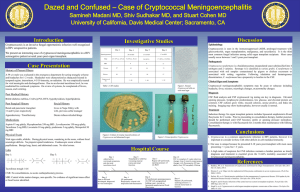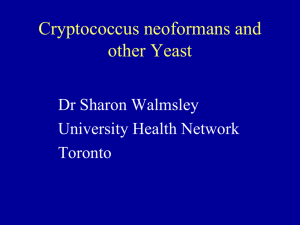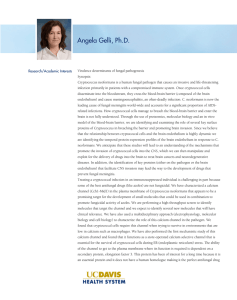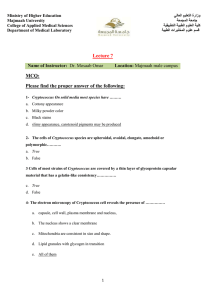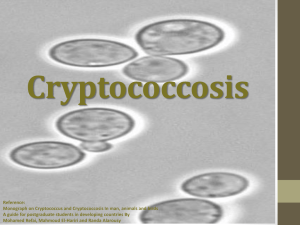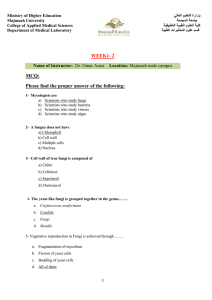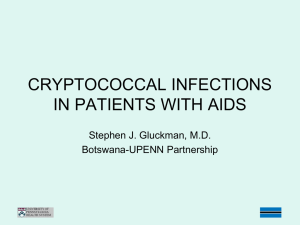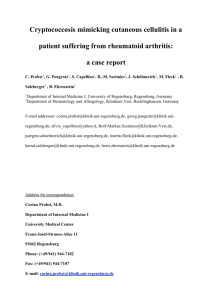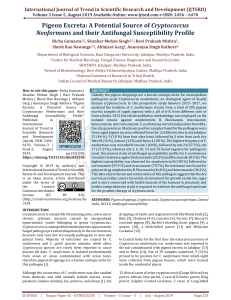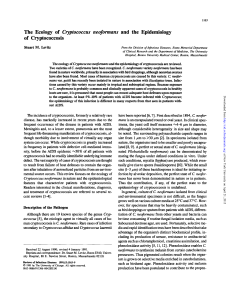JOHNS HOPKINS
advertisement
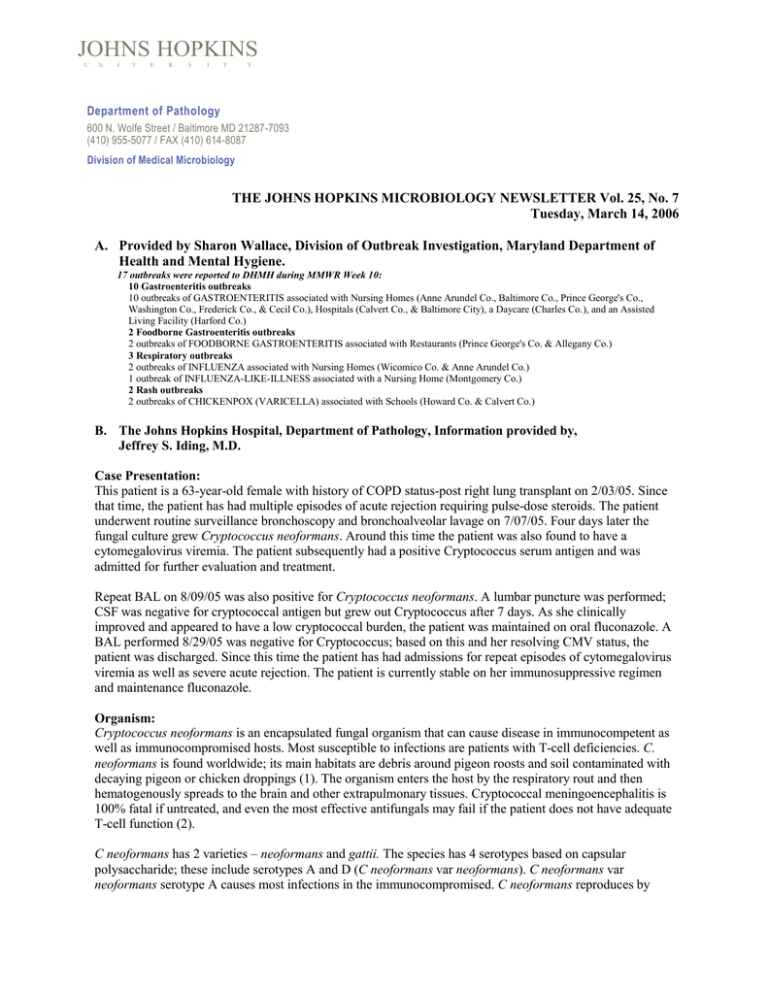
JOHNS HOPKINS U N I V E R S I T Y Department of Pathology 600 N. Wolfe Street / Baltimore MD 21287-7093 (410) 955-5077 / FAX (410) 614-8087 Division of Medical Microbiology THE JOHNS HOPKINS MICROBIOLOGY NEWSLETTER Vol. 25, No. 7 Tuesday, March 14, 2006 A. Provided by Sharon Wallace, Division of Outbreak Investigation, Maryland Department of Health and Mental Hygiene. 17 outbreaks were reported to DHMH during MMWR Week 10: 10 Gastroenteritis outbreaks 10 outbreaks of GASTROENTERITIS associated with Nursing Homes (Anne Arundel Co., Baltimore Co., Prince George's Co., Washington Co., Frederick Co., & Cecil Co.), Hospitals (Calvert Co., & Baltimore City), a Daycare (Charles Co.), and an Assisted Living Facility (Harford Co.) 2 Foodborne Gastroenteritis outbreaks 2 outbreaks of FOODBORNE GASTROENTERITIS associated with Restaurants (Prince George's Co. & Allegany Co.) 3 Respiratory outbreaks 2 outbreaks of INFLUENZA associated with Nursing Homes (Wicomico Co. & Anne Arundel Co.) 1 outbreak of INFLUENZA-LIKE-ILLNESS associated with a Nursing Home (Montgomery Co.) 2 Rash outbreaks 2 outbreaks of CHICKENPOX (VARICELLA) associated with Schools (Howard Co. & Calvert Co.) B. The Johns Hopkins Hospital, Department of Pathology, Information provided by, Jeffrey S. Iding, M.D. Case Presentation: This patient is a 63-year-old female with history of COPD status-post right lung transplant on 2/03/05. Since that time, the patient has had multiple episodes of acute rejection requiring pulse-dose steroids. The patient underwent routine surveillance bronchoscopy and bronchoalveolar lavage on 7/07/05. Four days later the fungal culture grew Cryptococcus neoformans. Around this time the patient was also found to have a cytomegalovirus viremia. The patient subsequently had a positive Cryptococcus serum antigen and was admitted for further evaluation and treatment. Repeat BAL on 8/09/05 was also positive for Cryptococcus neoformans. A lumbar puncture was performed; CSF was negative for cryptococcal antigen but grew out Cryptococcus after 7 days. As she clinically improved and appeared to have a low cryptococcal burden, the patient was maintained on oral fluconazole. A BAL performed 8/29/05 was negative for Cryptococcus; based on this and her resolving CMV status, the patient was discharged. Since this time the patient has had admissions for repeat episodes of cytomegalovirus viremia as well as severe acute rejection. The patient is currently stable on her immunosuppressive regimen and maintenance fluconazole. Organism: Cryptococcus neoformans is an encapsulated fungal organism that can cause disease in immunocompetent as well as immunocompromised hosts. Most susceptible to infections are patients with T-cell deficiencies. C. neoformans is found worldwide; its main habitats are debris around pigeon roosts and soil contaminated with decaying pigeon or chicken droppings (1). The organism enters the host by the respiratory rout and then hematogenously spreads to the brain and other extrapulmonary tissues. Cryptococcal meningoencephalitis is 100% fatal if untreated, and even the most effective antifungals may fail if the patient does not have adequate T-cell function (2). C neoformans has 2 varieties – neoformans and gattii. The species has 4 serotypes based on capsular polysaccharide; these include serotypes A and D (C neoformans var neoformans). C neoformans var neoformans serotype A causes most infections in the immunocompromised. C neoformans reproduces by budding and forms round yeastlike cells 3-6 um in diameter. It possesses several virulence factors, the dominant of which is likely its polysaccharide capsule, which has antiphagocytic and probable immunosuppressive properties (3). Epidemiology and Clinical Significance: Since the mid 1980s, most cryptococcal disease has occurred in patients with AIDS. A 2005 study reviewing data from 1981-2000, the first 2 decades of the AIDS epidemic, showed that the annual incidence per million personyears was 19 cases in men and 2.6 cases in women (compared to 1-2 new cases per million person-years in the pre-AIDS era)(4). Today, approximately 7-15% of patients with AIDS develop cryptococcal infections. In 1993, the US Centers for Disease Control and Prevention reported that 6% of 274,150 patients with AIDS developed cryptococcal disease; furthermore, patients with AIDS-associated cryptococcal infections now account for 8090% of all patients with cryptococcosis. As mentioned previously, cryptococcal meningitis and disseminated disease were inevitably fatal prior to the introduction of effective antifungal therapies. Still, in 1995, a 14% mortality rate in patients with cryptococcal disease treated with amphotericin B plus flucytosine and a 28% mortality rate for patients treated with other regimens was being reported (5). Pulmonary cryptococcal infections may occur in the absence of extrapulmonary manifestations (and vice versa), and may range from being virtually asymptomatic to causing acute respiratory distress syndrome in immunocompromised patients. CNS cryptococcosis may similarly present in a variety of ways but headache, altered mental status, nausea and vomiting are common; fever and stiff neck less so. After the lungs and CNS, the most common sites of disseminated infections are the skin, prostate, and medullary cavity of bones. Laboratory Diagnosis: Until recently it has been standard practice in our mycology laboratory to identify all fungal organisms grown from all respiratory specimens including those having normal upper respiratory flora so as not to miss C. neoformans. Our new protocol is to screen all respiratory yeasts for urease activity to detect potential C. neoformans isolates (Cryptococcus species typically produce urease as opposed to several non-pathogenic respiratory yeasts). Urease negative yeasts will not be further identified and will be signed out as normal flora no further id to follow. Generally, yeast isolates can be suspected as a Cryptococcus species when mucoid colonies are observed on recovery media. Positive urease tests, as mentioned, also suggest cryptococcal presence. If a species of Cryptococcus is suspected in the identification of an unknown yeast, C. neoformans must be specifically ruled in or out by biochemical and/or serologic testing. The biochemical tests traditionally involve the capacities of the different cryptococcal species to assimilate a variety of sugars as well as the ability to reduce nitrates to nitrites (C. neoformans lacks this ability). Furthermore, Kaufmann and Merz have described two rapid pigmentation tests that are highly sensitive for the detection of melanin pigment produced by C. neoformans (6). Use of the urease, nitrate reduction, and pigmentation tests makes rapid and definitive identification of C. neoformans possible in some circumstances. Serologic testing remains an important adjunct to diagnosis. In patients with meningitis, cryptococcal antigen is positive in more than 90% and serum is positive in approximately 75%. Treatment: Treatment of cryptococcal infection depends on infection type and the patient’s immune status. Pulmonary infections in immunocompetent hosts may resolve without specific therapy. All other situations require antifungal treatment, usually involving amphotericin B, flucytosine, fluconazole, or amphotericin B/5-FC combination. Treatment of HIV patients is further distinguished by life-long cryptococcal suppression after management if initial infection. References: 1. 2. 3. 4. 5. 6. Kwon-Chung KJ. Cryptococcosis. In: Medical Mycology. Philadelphia: Lea & Febiger, 1992:397-446. Mitchell TG, Perfect JR. Cryptococcosis in the era of AIDS-100 years after the discovery of Cryptococcus neoformans. Clin Microbiol Rev 1995;8:515-48. Buchanan KL, Murphy JW. What makes Cryptococcus neoformans a pathogen? Emerg Inf Dis 1998;4:71-83. Friedman GD, et al: Cryptococcosis: the 1981-2000 epidemic. Mycoses 2005 Mar; 48(2): 122-5. Speed B, Dunt D: Clinical and host differences between infections with the two varieties of Cryptococcus neoformans. Clin Infect Dis 1995 Jul; 21(1): 28-34; discussion 35-6. Kaufmann CS, Merz WG: Two rapid pigmentation tests for identification of Cryptococcus neoformans. J Clin Microbiol 1982 15:339-341.
